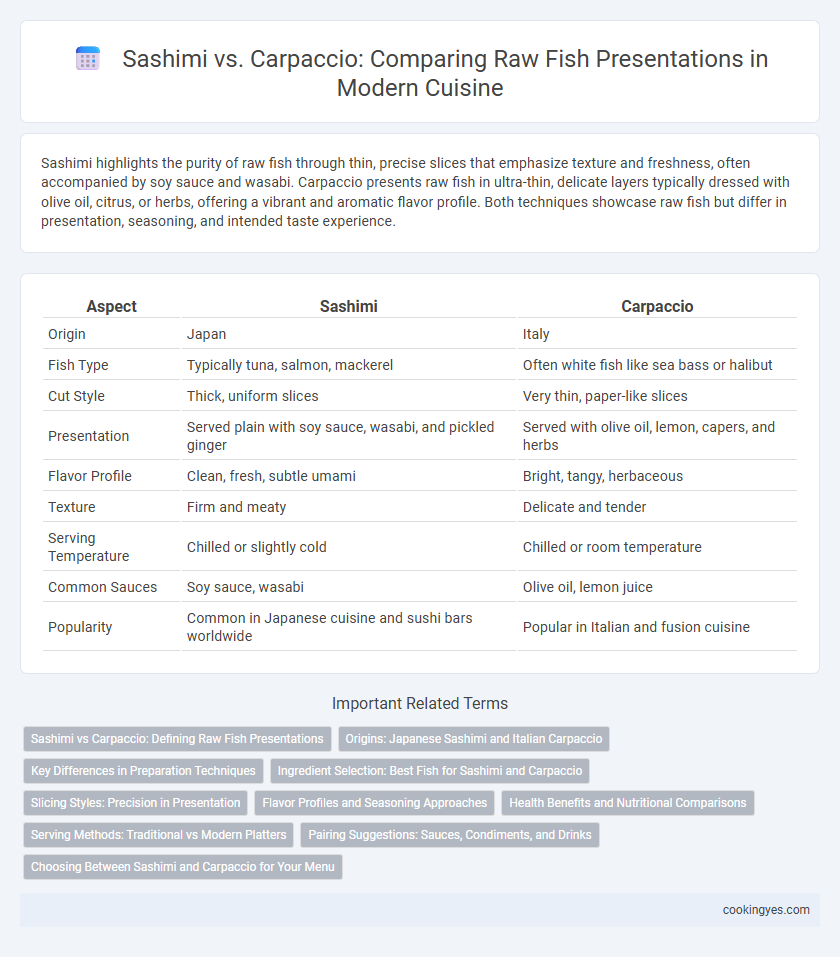Sashimi highlights the purity of raw fish through thin, precise slices that emphasize texture and freshness, often accompanied by soy sauce and wasabi. Carpaccio presents raw fish in ultra-thin, delicate layers typically dressed with olive oil, citrus, or herbs, offering a vibrant and aromatic flavor profile. Both techniques showcase raw fish but differ in presentation, seasoning, and intended taste experience.
Table of Comparison
| Aspect | Sashimi | Carpaccio |
|---|---|---|
| Origin | Japan | Italy |
| Fish Type | Typically tuna, salmon, mackerel | Often white fish like sea bass or halibut |
| Cut Style | Thick, uniform slices | Very thin, paper-like slices |
| Presentation | Served plain with soy sauce, wasabi, and pickled ginger | Served with olive oil, lemon, capers, and herbs |
| Flavor Profile | Clean, fresh, subtle umami | Bright, tangy, herbaceous |
| Texture | Firm and meaty | Delicate and tender |
| Serving Temperature | Chilled or slightly cold | Chilled or room temperature |
| Common Sauces | Soy sauce, wasabi | Olive oil, lemon juice |
| Popularity | Common in Japanese cuisine and sushi bars worldwide | Popular in Italian and fusion cuisine |
Sashimi vs Carpaccio: Defining Raw Fish Presentations
Sashimi is a traditional Japanese raw fish dish featuring thinly sliced, high-quality fish served without seasoning, emphasizing purity and texture. Carpaccio, originating from Italian cuisine, involves paper-thin raw fish slices typically drizzled with olive oil, citrus, or sauces, offering a more seasoned and varied flavor profile. Both presentations highlight raw fish but differ in cultural roots, preparation techniques, and accompanying ingredients.
Origins: Japanese Sashimi and Italian Carpaccio
Japanese sashimi, a traditional delicacy, features thinly sliced raw fish served without accompaniment to highlight freshness and texture, originating from Japan's emphasis on minimalism and natural flavors. Italian carpaccio, developed in the 1950s in Venice, consists of paper-thin slices of raw fish often dressed with olive oil, lemon, and capers to enhance the taste, reflecting Italy's culinary flair for vibrant and balanced seasoning. Both dishes showcase raw fish heritage but differ in cultural influences and presentation styles unique to their origins.
Key Differences in Preparation Techniques
Sashimi involves thinly slicing fresh, high-quality raw fish served without rice, emphasizing the purity and texture of the fish. Carpaccio, originally an Italian dish, features raw fish sliced even thinner or pounded thin, typically dressed with olive oil, lemon juice, and seasonings to enhance flavor. The key difference lies in sashimi's focus on simplicity and freshness, while carpaccio highlights flavor infusion through dressing and marinades.
Ingredient Selection: Best Fish for Sashimi and Carpaccio
Sashimi features premium, fatty fish like salmon, tuna, and yellowtail for rich flavor and tender texture, emphasizing freshness and quality. Carpaccio often uses thinner slices of leaner fish such as sea bass, snapper, or flounder, highlighting delicate flavors enhanced with citrus or olive oil dressings. The key to both presentations lies in selecting the highest-grade, sushi-grade fish to ensure safety and optimal taste.
Slicing Styles: Precision in Presentation
Sashimi features ultra-thin, delicate slices of raw fish expertly cut to enhance texture and flavor, typically using a yanagiba knife for precision. Carpaccio, inspired by Italian cuisine, consists of paper-thin, translucent slices often drizzled with olive oil or citrus to complement the raw fish's natural taste. The precise slicing styles in both presentations are crucial for achieving the ideal mouthfeel and visual appeal, showcasing the chef's skill in preparing raw fish.
Flavor Profiles and Seasoning Approaches
Sashimi features thinly sliced raw fish with a clean, delicate flavor that highlights the freshness of the seafood, often accompanied by minimal seasoning such as soy sauce, wasabi, and pickled ginger to enhance without overpowering. Carpaccio, originating from Italian cuisine, involves raw fish sliced paper-thin and dressed with olive oil, citrus juices, herbs, and sometimes a hint of spice, creating a brighter, more complex flavor profile. The seasoning approach in sashimi emphasizes subtlety and purity, while carpaccio embraces a bold, layered taste experience through its vinaigrette-style dressings and aromatic herbs.
Health Benefits and Nutritional Comparisons
Sashimi offers high protein content with minimal calories, rich in omega-3 fatty acids that promote heart health and brain function. Carpaccio, while similar, often includes a marinade or dressing that can add antioxidants and healthy fats but may increase sodium levels. Both raw fish presentations provide essential vitamins like B12 and D, though sashimi is typically lower in added ingredients, favoring a purer nutritional profile.
Serving Methods: Traditional vs Modern Platters
Sashimi is traditionally served on simple, often wooden platters with minimal garnishes like shredded daikon and shiso leaves to highlight the fresh fish's texture and flavor. Carpaccio, originating from Italian cuisine, is presented on flat plates with artistic drizzles of olive oil, citrus, and herbs, offering a modern and colorful visual appeal. The serving methods reflect cultural origins, with sashimi emphasizing purity and carpaccio focusing on vibrant, contemporary presentation.
Pairing Suggestions: Sauces, Condiments, and Drinks
Sashimi pairs excellently with soy sauce, wasabi, and pickled ginger, enhancing the clean flavors of raw fish, while sake or light-bodied white wines like Sauvignon Blanc complement its delicate texture. Carpaccio, often drizzled with olive oil, lemon juice, and sprinkled with capers or herbs, benefits from more robust accompaniments such as a zesty vinaigrette and a crisp, chilled Chardonnay or a citrus-forward gin cocktail. Both dishes thrive with simple, fresh accompaniments that highlight their unique flavor profiles without overpowering the fish.
Choosing Between Sashimi and Carpaccio for Your Menu
Sashimi features thinly sliced raw fish served plain, emphasizing freshness and the natural texture, ideal for traditional Japanese menus prioritizing authenticity. Carpaccio presents raw fish in ultra-thin slices drizzled with olive oil, citrus, and seasonings, appealing to guests seeking vibrant flavors and a Mediterranean twist. Selecting between sashimi and carpaccio depends on your culinary style and desired flavor profile, balancing pure fish essence against enhanced, layered tastes.
Sashimi vs Carpaccio for raw fish presentations Infographic

 cookingyes.com
cookingyes.com